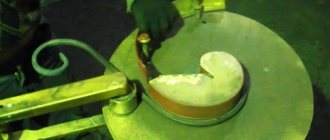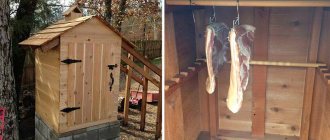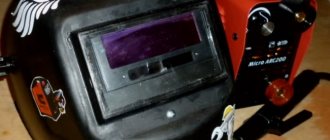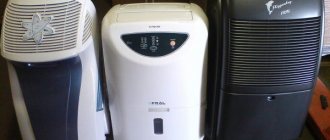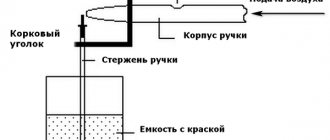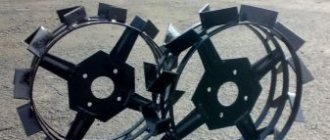Snail fans get their name from the shape of the body, which resembles the shell of this mollusk. Today this type of equipment is used both in industry and in residential construction in ventilation systems. Manufacturers today offer several models of snails for ventilation. But they all work on the same principle - the centrifugal force created by the rotation of the blades on the rotor captures air through a snail-shaped inlet and pushes it through a straight outlet located at 90° in a different plane to the inlet.
General information about centrifugal (radial) fans
Coil fans have a dual designation (marking): VR and VC, that is, radial and centrifugal. The first indicates that the blades of the working part of the equipment are located radially relative to their rotor. The second is the designation of the physical principle of operation of the device, that is, the process of intake and movement of air masses occurs due to centrifugal force.
It is centrifugal fans in ventilation systems that have shown themselves on the positive side due to the high efficiency of air removal.
Operating principle
As already mentioned, fans of this modification operate based on the action of centrifugal force.
- The blades attached to the rotor of the device rotate at high speed, creating turbulence inside the housing.
- The inlet pressure drops, which causes the suction of nearby air, which rushes inward.
- Under the action of the blades, it is thrown to the periphery of the space, where high pressure is created.
- Under its action, the air flow rushes to the outlet pipe.
This is how all centrifugal models work, which are installed not only in ventilation systems, but also in smoke removal systems. About the latter, it must be said that their body is made of aluminum alloy or steel, coated with heat-resistant materials, and is equipped with an explosion-proof electric motor.
Design Features
As already mentioned, the main design feature is the snail. It is also necessary to indicate the shape of the blades. Fans of this brand use three types:
- with straight slope,
- with a backward tilt
- in the form of a wing.
The first position is small fans with high power and performance. That is, they can create conditions in which other models require a large body. At the same time, they operate with low noise levels. The second position is an economical option that consumes 20% less electricity than other positions. Such fans can easily withstand loads.
As for the design that relates to the electric motor, there are also three positions:
- the rotor is fixed directly to the motor shaft through a coupling and bearings;
- through a belt drive using pulleys;
- The impeller is mounted on the electric motor shaft.
And one more feature is the connection points between the fan and the air ducts of the ventilation system. The inlet pipe has a rectangular hole shape, the outlet is round.
Design features
A snail hood is a radial fan built into a specially shaped housing, reminiscent of a snail's shell. Air is directed into it under the influence of centrifugal force.
The centrifugal fan consists of the following parts:
- Spiral shaped body.
- The suction pipe is round in shape, the diameter size coincides with the size of the impeller.
- An exhaust duct ending in an outlet pipe.
- The outlet pipe is rectangular in shape and is located with the throat facing up.
- Impeller with blades.
- Electric motor.
The center of the housing is occupied by the fan impeller. Its blades differ from the usual large ones, starting from the axis of rotation. In a radial fan, the impeller blades are rectangular, straight or curved in a certain way, and are located along the rim of the circle of rotation.
The shape of the snail hood blades depending on the purpose:
- straight – for removing volatile suspended matter (dust, small chips);
- with the blade bent backwards - to increase the speed of rotation of the wheel with reduced noise generation;
- with the blade bent forward - to increase the pressure and efficiency of the engine.
The design features of a radial fan lie in the different ways of transmitting torque from the engine to the impeller:
- The impeller is “mounted” directly on the motor shaft. This design is simple and accessible. However, if the fan breaks down, it must be completely disassembled for repair work.
- Torque is transmitted via a belt. A common type of interaction between a motor and rotating parts of a mechanism, which opens up many possibilities for manipulating pulley sizes and speeds. The belt drive makes the device more bulky and expensive.
- The impeller is connected to the motor shaft through a coupling. This fit relieves the load on the engine bearings without increasing the complexity and metal consumption of the design. This type of snail hood can be considered the best in terms of maintainability and price.
We recommend that you read: Ventilation in a boiler room with a gas boiler
The speed of a snail-type hood is regulated not only by the power of the motor, but also by the number of blades on the impeller. The fan housing is made of steel, alloys or aluminum. To protect against corrosion, steel parts are painted or coated with special protection.
Kinds
Types of centrifugal fans of snails are three positions, differing from each other in power. This parameter depends on the rotation speed of the electric motor, and therefore the rotor, as well as on the number of blades in the device design. Here are three types:
- Low pressure volute fans, the parameter of which does not exceed 100 kg/cm². Most often they are used in ventilation systems of apartment buildings. Install snails on roofs.
- Medium pressure models – 100-300 kg/cm². Installed in ventilation systems of industrial facilities.
- High pressure variety – 300-1200 kg/cm². These are powerful fan units, which are usually included in the air exhaust system of paint shops, in industries where pneumatic transport is installed, in warehouses with fuels and lubricants and other premises.
There is another division of snail fans - according to their purpose. These are primarily general purpose devices. Then there are three more positions: explosion-proof, heat-resistant and corrosion-resistant.
Operating principle of a centrifugal fan
Inside the vacuum cleaner we see a picture:
- Air from the bag (tank, container), cleaned of dust, approaches the engine from the front and enters the center of the drum.
- The molecules, accelerated by the blades to a significant speed, are thrown out. They pass through the channels of the sealed housing, simultaneously cooling the engine, and leave the belly of the vacuum cleaner from the back side.
Design feature: the blades of a centrifugal fan create pressure; if the housing is leaky, the air flow will be disrupted. Therefore, the difficulty for a self-taught master is to create the right conditions.
Good hoods use motors with tangential (centrifugal) type fans. In selected designs, the design surprises with a duet of squirrel cages. In the latter case, a pair of impellers is mounted on either side of the engine on a shaft. Then the air enters from two directions perpendicular to the plane of rotation of the wheels. Thus, the efficiency of the centrifugal fan increases.
Restrictions on use
Manufacturers and experts recommend installing volutes in ventilation systems that are not used for air exhaust:
- with sticky suspensions with a concentration of more than 10 mg/m³;
- with fibrous materials in the air;
- with explosive inclusions;
- with corrosive particles;
- and in warehouses where explosives are stored.
In all other cases, snails can be used without restrictions. And one more point that regulates the conditions of their operation is the temperature regime, which cannot be violated: from -45C to +45C.
Features of use and limitations
General purpose radial fans can be operated in the temperature range from -45 to +45 degrees. This limitation does not apply to specialized devices that have separate settings.
Restrictions for installing a general purpose volute hood:
- the presence of sticky impurities in the air mixture is more than 10 mg/m³;
- the presence of fibrous impurities;
- for the removal of explosive gas mixtures;
- in premises where explosives are stored;
- the presence of chemically aggressive substances in the air mixture.
For ventilation systems with special requirements, VRP, VRDU fans, heat-resistant and explosion-proof models are used.
Source
Popular models
In principle, there is no model division of snails. There are certain brands that are produced by all manufacturers. And they are divided mainly according to their intended purpose. For example, a VRP fan, where the letter “P” means that this is a dust model, which is used in ventilation and aspiration systems to remove air with a high concentration of dust. That is, this is a specific model that must be used for its intended purpose. Of course, this device can easily handle ordinary air, but it is more expensive than standard VR or VC, because its design uses thick metal to make the body and blades, hence the higher power of the electric motor.
The same applies to VR DU brand fans, that is, for smoke removal. They are made from higher quality materials with the installation of an explosion-proof motor. Hence their high price. As for other positions, VR is divided into types that have already been mentioned, and each group has its own models with its own technical characteristics.
Peculiarities
The main feature of a scroll fan is its ability to create high outlet pressure
. Axial structures have high performance, but most of them are not capable of creating pressure. Therefore, only “snails” are suitable for working with a complex air duct system with high aerodynamic resistance.
Based on the amount of pressure created, they are divided into three categories:
create a vacuum to work both for discharge and suction
additional functions
transport bulk materials through the air duct system
The most popular models of “snail” fans are VR and VTs
(
Radial Fan
and
Centrifugal Fan
). Some complication of the situation in this regard is that there are no special rules for naming fans and each manufacturer has the right to name their products as they see fit. Therefore, models of “snail” fans often appear that have exactly the same parameters, but different designations.
Unity of standard sizes is necessary for the possibility of connection to other equipment -, etc. In this regard, the situation is more successful; the fans fit completely into adjacent elements of the system. If models and elements of different standard sizes are used, then appropriate adapters are used to pair them.
How to make it yourself
The question posed by the title of this section can be classified as rhetorical. That is, in principle, you can make a snail with your own hands if you have the skills of a tinsmith or welder. Because the device will have to be assembled from sheet metal. And depending on the power and performance of the device, the metal will have different thicknesses.
Plus, making the blades yourself and attaching them to the rotor properly is difficult. Because the rotor will rotate at enormous speed, and if the balancing of the structure is upset, the fan will be torn apart in the first 20 seconds of operation. Yes, and you need to choose the right electric motor, taking into account the power and rotation speed, plus correctly connect it to the fan rotor. So don’t try to do anything with your own hands - it’s dangerous for your own life.
Mechanical ventilation
Note. Blower/suction units with an electric motor, which are called “snails,” are not suitable for any type of ventilation, since they can only direct the air flow in one direction.
Types of ventilation
Ventilation tree
- As you can see in the top image, the word “ventilation” can mean completely different methods of air exchange and some you may not have even heard of, but we will briefly consider only the most basic of them.
- Firstly, there is a well-known exhaust method, when warm or polluted air is removed from the room.
- Secondly, there is a supply option and most often this is the addition of fresh cool air.
- Thirdly, this is a combination, that is, a supply and exhaust option.
- The above systems can function naturally, but can also be forced using axial (axial), radial (centrifugal), diametrical (tangential) and diagonal fans. In addition, exhaust and air supply can be carried out either in general or in local mode. That is, the air duct is supplied to a specific destination and performs the function of blowing or exhaust.
Examples
Note. Below we will look at several types of snails that are used for basic types of ventilation.
BDRS 120-60
BDRS 120-60 (Turkey) is a radial-type exhaust volute with a weight of 2.1 kg, a frequency of 2325 rpm, a voltage of 220/230V/50Hz and a maximum power consumption of 90W. At the same time, BDRS 120-60 is able to pump a maximum of 380 m3/min of air with a temperature range from -15⁰C to +40⁰C, and has a safety class of IP54.
The BDRS brand can have several standard sizes; the external rotary motor is made of galvanized steel and is protected on the side by a chrome grille, which prevents foreign elements from getting onto the impeller.
Dundar CM 16.2H
The heat-resistant supply and exhaust radial fan Dundar CM 16.2H is usually used to pump out hot air from solid fuel boilers, although the instructions also allow it to be used for premises for various purposes. The air flow during transportation can have a temperature from -30⁰C to +120⁰C, and the snail itself can be rotated to 0⁰ (horizontal position), 90⁰, 180⁰ and 270⁰ (motor on the right side).
The CM 16.2H model has a motor speed of 2750 rpm, a voltage of 220/230V/50Hz and a maximum power consumption of 460W. The unit weighs 7.9 kg and is capable of pumping a maximum volume of 1765 m3/min of air, a pressure level of 780 Pa, and has a protection degree of IP54.
VENTS VSCHUN
Various modifications of VENTS VSCHUN can be used for the needs of supply and exhaust ventilation and air conditioning in premises for various purposes and have an air transportation capacity of up to 19000 m3/hour.
Such a centrifugal scroll has a spiral-rotating body and an impeller, which is mounted on the axis of a three-phase asynchronous motor. The VSCHUN body is made of steel, which is later coated with polymers
Any modification implies the ability to rotate the body to the right or left. This allows you to connect to existing air ducts at any angle, but the step between the fixed position is 45⁰.
Also, different models can use either two-stroke or four-stroke asynchronous motors with an external rotor, and its impeller in the form of forward-curved blades is made of galvanized steel. Rolling bearings increase the operating life of the unit, factory-balanced turbines significantly reduce noise, and the protection level is IP54.
Supply and exhaust system. Photo
In addition, for VSCHUN it is possible to adjust the speed yourself using an autotransformer regulator, which is very convenient when:
- change of seasons;
- working conditions;
- premises and so on.
In addition, several units of this type can be connected to an autotransformer device at once, but the main condition must be met - their total power should not exceed the rating of the transformer.
| Specifying a parameter | VTsUN | |||||||
| 140×74-0,25-2 | 140×74-0,37-2 | 160×74-0,55-2 | 160×74-0,75-2 | 180×74-0,56-4 | 180×74-1,1-2 | 200×93-0,55-4 | 200×93-1,1-2 | |
| Voltage (V) at 50Hz | 400 | 400 | 400 | 400 | 400 | 400 | 400 | 400 |
| Power consumption (kW) | 0,25 | 0,37 | 0,55 | 0,75 | 0,55 | 1,1 | 0,55 | 1,1 |
| Current )A) | 0,8 | 0,9 | 1,6 | 1,8 | 1,6 | 2,6 | 1,6 | 2,6 |
| Air flow maximum (m3/hour) | 450 | 710 | 750 | 1540 | 1030 | 1950 | 1615 | 1900 |
| Rotation speed )rpm) | 1350 | 2730 | 1360 | 2820 | 1360 | 2800 | 1360 | 2800 |
| Sound level at 3m (db) | 60 | 65 | 62 | 68 | 64 | 70 | 67 | 73 |
| Air temperature during transportation maximum t⁰C | 60 | 60 | 60 | 60 | 60 | 60 | 60 | 60 |
| Protection | IP54 | IP54 | IP54 | IP54 | IP54 | IP54 | IP54 | IP54 |
Technical characteristics of VENTS VSCHUN
Note. The table above shows the technical characteristics of only some modifications of VENTS VSCHUN.
Features of the snail hood
The memorable shape and distinctive operating principle make this type of ventilation stand out from similar ones. The most popular snail will be for rooms with a minimum area and free space. The design of the fan in the form of a spiral serves as an air duct in any warehouse or industrial premises.
There are different configurations available for your choice, but if you wish, it is quite possible to build a cleaning system with your own hands. How to install a snail and why is it better than other cleaning systems? The answers to these questions lie in the structural features of the device.
